The Rand Building: 14 Lafayette Square
The site occupied by the Rand building today was labeled, "Lot 16" on an 1825 map of the village of Buffalo. In the 1830's, when Buffalo achieved the status of a city, it was a lumber yard. Beginning in 1833, several churches started up on the site but failed. In 1845, Dr. Grosvenor Heacock started a new church, named the Park Church Society; later it was renamed the Lafayette Street Presbyterian Church, after the name of the street it fronted (now called Broadway). This church was a success, despite the 1850 fire which destroyed it. The rebuilt church was demolished in 1862 for a new $25,000 building (below) that accomodated the growing congregation.

c. 1890. Image source: Picture Book of Earlier Buffalo
The church was referred to as "Dr. Heacock's Church" and, when he died in 1877, some residents sought to have the square that had been called 'Court House Square" renamed "Heacock Square" in his honor. The city, however, elected to officially name the plot of land Lafayette Square, which it retains today. In 1879, the new German Insurance building (above left) signalled the expansion of Buffalo's business district from lower Main Street. The church's congregation was also expanding and, in 1896, the church moved north and west to Bouck Street (which was later renamed "Lafayette Avenue" at the church's request).
The structure at the corner was a private residence at this time.

c. 1905 Image source: private collection
The church sold its old building and it was remodeled into a burlesque house, the Lafayette Theater. It operated at this location from 1901 - 1913 when the owners moved their operations to the new Gayety Theater at Pearl and West Huron.
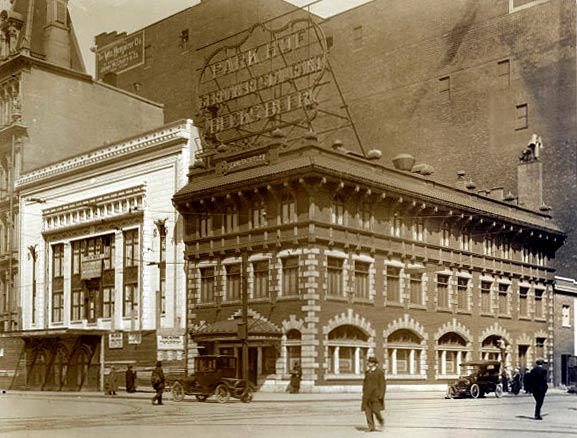
c. 1915 Image source: Buffalo & Erie County Library
In 1914, new owners took over and remodeled the building again for a movie theater and 4-day vaudeville programs; they called it the Olympic Theater. The building next door was demolished and a new building constructed around 1908 by Seames and Zeitler. They opened the Park Hof restaurant.
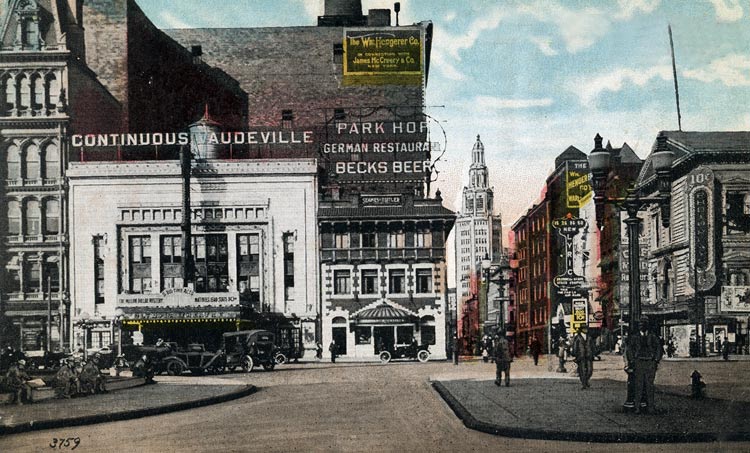
c. 1920 Image source: private collection.
The Park Hof became a famous political headquarters for locals. Here is an interior view of the Park Hof's gentlemen's cafe.
Briefly this corner building became the Lafayette National Bank, which would be purchased by the Marine Trust Company, the company that in 1924 would also purchase the Olympic Theater building. Shortly, the company would demolish both structures and make way for a new buildiing.
The architectural firms of James W. Kideney & Associates and Franklyn & William Kidd designed the art deco Rand building. It was the tallest building in Buffalo in 1929 and would remain so for 43 years (until the HSBC tower was built). It is 29 stories, 408 feet tall plus another 40 feet of beacon tower.
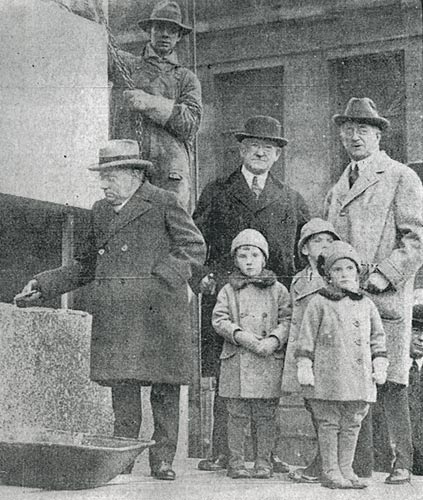
Buffalo Evening News, September 18, 1929
New Skyscraper Dedicated to
Memory of Dead Banker
"Laying of the cornerstone of the Rand building in Lafayette Square Monday afternoon dedicated the... $3,000,000 banking edifice to 'the highest business ideals'...
"When the cornerstone, a ton of Indiana limestone, had been lowered in place, it sealed in a cavity a copper box containing documents that hold an interesting record of the structure, its founders, and the city of Buffalo.
"George F. Rand [Jr.], president of the Marine Trust Company, wielded the trowel with which the sealing cement was laid upon the base on which the cornerstone was fitted. The trowel was new and shining. Cameras clicked as Mr. Rand plunged the trowel into the cement and a burst of hand-clapping came from the spectators...
"Three generations of the family most intimately connected with the growth of the bank were represented at the laying of the cornerstone. Two generations were represented in person by George F. Rand and his son and daughter, George F. Rand III and Isabelle H. Rand. George F. Rand Sr. was present in the memory of his intimate business associates who attended."
The 6 year-old boy in the center of the image is Charles Rand Penney.
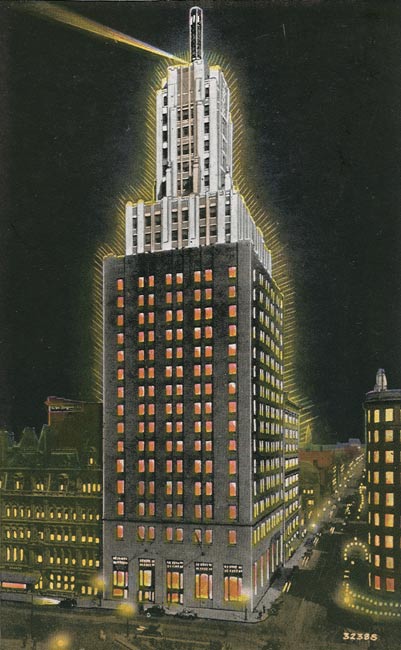 The Rand building was more than an office building and branch of the new Marine Midland Holding Company. Designed to facilitate the high technology of the time, it housed the main offices of the Western Union and the studios of WGR radio, so named because George Rand was a major investor in the local Federal Telephone & Telegraph Company.
The Rand building was more than an office building and branch of the new Marine Midland Holding Company. Designed to facilitate the high technology of the time, it housed the main offices of the Western Union and the studios of WGR radio, so named because George Rand was a major investor in the local Federal Telephone & Telegraph Company.
In addition, there was atop the 40-foot tower a neon aviation beacon.
Courier-Express May 2, 1929 Rand Building Aglow in Colored Lights
"By turning on a switch in a room on the sixteenth floor of the Hotel Statler, George Rand III, six-year old son of the president of the Marine Trust Company, flashed on the...strongest aviation beacon in the country, atop the Rand building in Lafayette Square at 9:25 last night...
"The lighting of the powerful Rand building beacon was heralded by four airplanes that took off from the Buffalo airport shortly after 9 o'clock. The planes circled the beacon and Hotel Statler and then flew back to the airport, guided by the directional ray oof the beacon.
"The beacon has two huge searchlights, one stationery, which is directed towards the airport, and the other a revolving light. The airport directional light is white and the revolving light red. The searchlights are placed on the very top of a tower covered by rows of neon tubes which give forth a brilliant red glow. Upon the beacon are directed floodlights, heightening the effect of aerial beauty which makes the beacon appear a castle builit in the sky.
"The revolving light, under normal conditions, can be seen at a distance of 100 miles. It is the contribution of the Marine Trust Company to the development of aviation in this city."
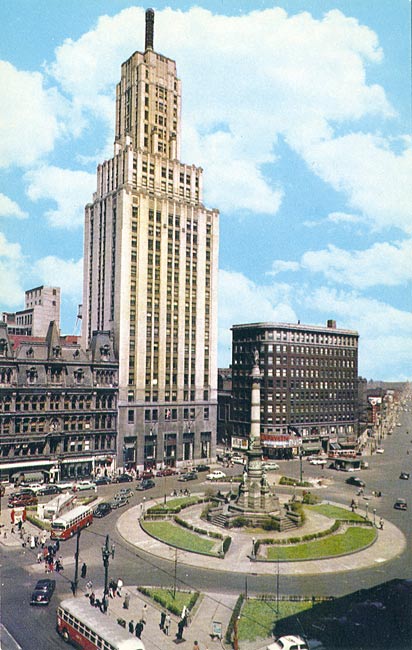
The Rand building dominates Lafayette Square in the 1950s.
Image source: private collection
The German Insurance building (left in photo), dwarfed by the Rand building, was demolished in 1957 for construction of the Tishman Building.
The building across Washington Street (center right in the photo) is the Lafayette Theater, the second theater on Lafayette Square to have that name. A movie house, it was demolished in 1962; the site remains a parking lot.
The Rand building changed hands in 1971 and again in 1976. It remains an office building.

The Rand Building and its neighbor, the Tishman building.